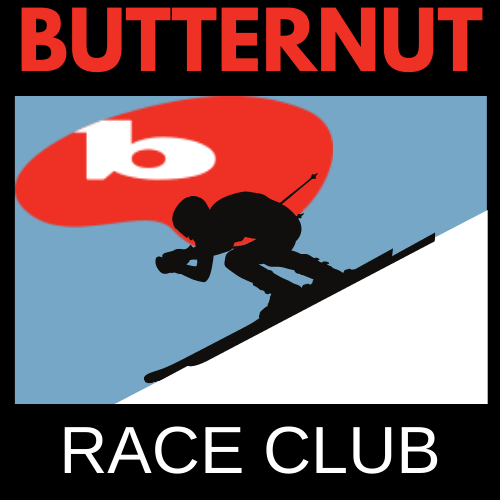Butternut Race Club
Tri-State
Tri-State is an all-day program that allows our more experienced racers an opportunity to compete at the highest levels. The focus is on continued skill development, with additional emphasis on more advanced skills and race tactics. The Tri-State program is smaller than Interclub and is divided into two groups (younger athletes are referred to as U12 & U14 racers, while the older athletes are referred to as U16 & U19). For the 2021-2022 season, the age groups are as follows, based on year of birth:
U12: 2010 & 2011
U14: 2008 & 2009
U16: 2006 & 2007
U19: 2003, 2004 & 2005
The schedule is generally consistent for the entire season. Keep in mind that despite variations in the weather (from pouring rain to bitter cold) the programs are never canceled, unless the mountain itself is closed. Ski Butternut disseminates the schedule and training focus each week via the TeamSnap app.
Within each program, there may be specific instructions given to the athletes regarding schedule changes, meeting points, or training plans. In addition, feel free to contact your child’s coach via TeamSnap with any questions.
To find additional information published by Ski Butternut:
Ski Butternut’s Tri-State Team Page
Tri-State Equipment List
Please see USSA Alpine Equipment Regulations for more details.
Skis - 2 pairs (U12 exception)
1 Pair of Giant Slalom Race Skis
1 Pair of Slalom Race Skis (optional for U12, who can use 1 pair mixed-model/multi-sport)
Boots – A proper fit is essential, as well as appropriate flex “ankle flexion”
Poles - 2 pairs (U12 exception)
1 set of GS poles
1 set of SL poles w/ with slalom guards (optional for U12 using mixed-model/multi-sport skis)
Helmet – Must be a hard ear race helmet, FIS Certified (No soft ear helmets allowed)
Slalom chin guard
Slalom shin guards
Goggles
Back protector (optional, strongly recommended)
GS suit (optional, strongly recommended)
U12 & U14
For the U12 racers, there are 4 races throughout the regular season, one slalom, one parallel slalom & two giant slaloms. The U14s race the same 4 races plus another slalom. The schedule along with the rules (once updated for this season) can be found here. All U12 racers qualify for the U12 Tri-State Championships.
Upon completion of the regular season races, the U14 athletes are ranked based on their finishes in each run of the races and can qualify for the U14 Tri-State Championships. The U14 Championship event comprises a race weekend with an awards banquet on Saturday night.
At the U12 & U14 championship events, our racers compete with the best racers from across southern New England. Connecticut, Thunder Ridge in NY, Eastern Massachusetts, and Rhode Island are represented at events.
In addition, success at the regular-season races by U12 and U14 athletes may qualify someone to represent Massachusetts for the Piche race in March and brings together the best racers from all of the Eastern Region states. Additionally, U14 racers may qualify for the U14 Eastern Championships based on their results at the Tri-State Championships. There is also a new U14 Eastern Finals this season. More information on this can be found on the Tri-State site once available.
U16
There are 4 regular season races plus 2 races at the U16 Tri-State Championships weekend. All U16 racers qualify for the championship weekend and their post-season opportunities are determined by their season-long results, not just specific results at championships. Seeding will be based upon current USSA points by discipline. This is the first age group that begins the process of racing in “scored events” which will result in determining a racer’s points. The method of determining a racer’s points is explained in the U.S. Ski & Snowboard Competition Guide beginning on page 26. Athletes begin their careers at 999 points in each discipline and work to lower them through good results against good competitor fields. The best person in the world in a given discipline starts the season with 0 points.
The U16 races have a random seed draw for the 15 athletes with the lowest points and then athletes are started in ascending order of points. 999s will be randomly seeded after racers with points. The second run start order will be flip 30 formats based upon first run finish time (meaning the 30th fastest will start first, then the 29th fastest will start 2nd and so on until the fastest person starts 30th. The 31st fastest will start 31st). DSQ/DNF will be a random draw after seeded racers. Full Tri-State U16 Rules can be found here when available.
U19 & U21
The U19 & U21 racers also compete in “scored events” which result in determining a racer’s points. Refer to the Competition Guide for a complete description. At these races, an athlete receives a numerical score based on their relative performance (similar to a golf handicap). Over time, an athlete can work to lower their “points” within a given discipline (SL, GS, SG & DH).
Not only do lower “points” provide an athlete with a better starting bib number, but they are also the pathway to higher-level races such as FIS Development and Eastern Cup races. Success can also open the door to a variety of post-season events as well. In order to experience racing at different levels & venues, you should check out races in nearby regions such as New Hampshire (nhara.org) and Vermont (vara.org). Most of these races are open to anyone who chooses to enter. Speak with your child’s coach about opportunities for extending the race season in this fashion.

